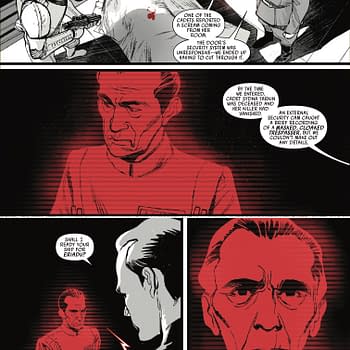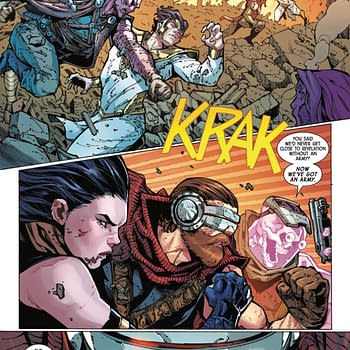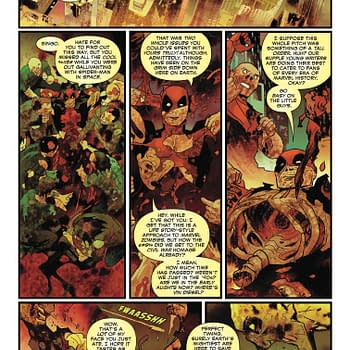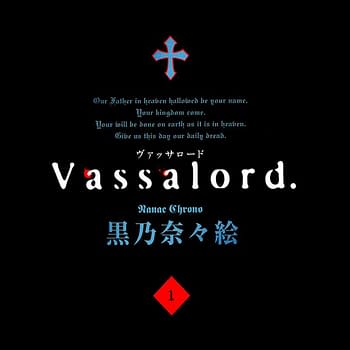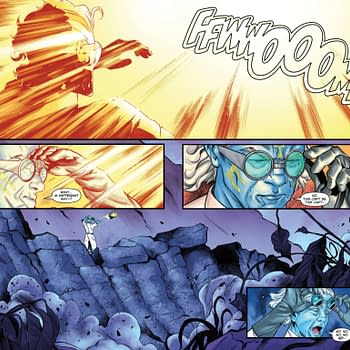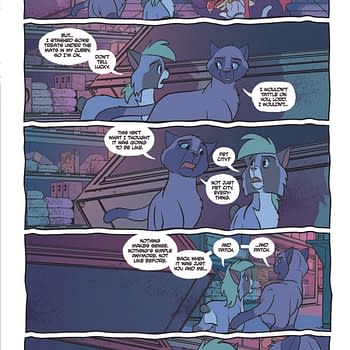Posted in: Comics | Tagged: christopher golden, Comics, dark horse, dave stewart, entertainment, Joe Golem: Occult Detective, mike mignola, Patric Reynolds
'It's The Characters Who Count' – Christopher Golden Walks Us Through Joe Golem: Occult Detective
Mike Mignola and Christopher Golden's co-created character Joe Golem, initially the star of a prose novel, has at last sprung to life in comics form as a character in an all-new story arc, "The Rat Catcher", arriving in a 5 issue series starting in November. Joe Golem is a character who's unique in many ways, not least in that he's an independent figure who moves in a world that's not located in the Hellboy Universe, but rather in a fictional version of a flooded New York City. In this story's initial issue, he reflects on his own troubled past, the fate of children in the city who are being dragged to their deaths in the murky canals that are so much a part of their life, and sets out to end the suffering by hunting down the creature responsible.
As strange as it may sound to say, one of the most winning aspects of this character and this story for me is the layer of subtle melancholy and reverie that informs Patric Reyold's painterly artwork and Dave Stewart's colors. Stewart is surprising in this issue for shaking off the bold hues usually associated with his work and finding such a perfect tone in the many layers of monochrome that you feel the city is as solid as stone or as solid as the stony face of Joe Golem himself. All of these features make this a story unlike those you've seen previously from these talented creators–they've provoked a new kind of alchemy through their collaboration and created a new world with an entirely new ethos to explore and connect with emotionally.
Christopher Golden kindly took the time to speak with me about the book, and his answers actually exceeded my expectations in terms of taking us further into characterization for Joe Golem and further into the personality of his city than would have sufficed. Clearly this is a passion project for Golden and his creative connection to the book really comes through in this discussion.

Christopher Golden: In both cases, we're dealing with characters and plots that are at the core of much larger worlds. With both original novels (BALTIMORE, OR, THE STEADFAST TIN SOLDIER AND THE VAMPIRE and JOE GOLEM AND THE DROWNING CITY) Mike and I spent a lot of time envisioning and fleshing out these worlds. Some things were just sketched in, mentally, but in many cases we had fully imagined portions of those worlds. When you've done that advance work—when you're familiar with it—there are two major challenges that come to mind.
First, you've got to remember that only a tiny handful of the people who are reading the comics will be familiar with the novel, so you have to introduce the world to them for the first time, and construct it carefully, building slowly. Second, you've got to decide when in the narrative you're going to begin the comics series. With BALTIMORE, we made the decision to start by filling in the missing years that we didn't cover in the novel, even though we didn't expect readers to know what happened in the novel. At the same time, it was vital that we tell Baltimore's origin story in the first miniseries, THE PLAGUE SHIPS. So we structured that first miniseries in such a way as to allow Baltimore to tell his "origin story" in the midst of an ordeal that starts creepy and then becomes terrifying.
With JOE GOLEM: OCCULT DETECTIVE, we're beginning a full decade before the events of the novel. I almost wish that Dark Horse hadn't even mentioned the novel in solicitations. We're creating a comics series that will follow the novel's continuity—when we get to it—but our goal was to build up the bizarre world of Joe Golem, Simon Church, the Drowning City, and 15th century flashbacks to the witch-hunting golem, so it lives and breathes on its own. Instead of the comics growing organically out of the novel (as we did with BALTIMORE), we're retroactively creating a comic book series that will organically lead up to the events of the novel. And maybe beyond.

CG: Working with Mike Mignola, it's impossible not to have an incredibly visual conception of the world you're creating. I could see the Drowning City in my mind while I was writing it, and then Mike began to do what I think of as his "window" illustrations of the setting, these little glimpses into the world. I wrote it visually, as much as I'm able. We've been developing the movie version of the novel for a while with Constantin Films and director Alex Proyas. Alex wrote the first draft of the screenplay and I did the second draft. Certainly, Mike and I have encountered plenty of readers in person and online who have pushed for a comics version of this. I'm sure the existence of BALTIMORE as a comics series helped to create a sort of expectation in readers. Many assumed we would eventually do some kind of JOE GOLEM comics. But to be honest, we've created JOE GOLEM: OCCULT DETECTIVE for ourselves, not for the readers. I hope people love it, of course. But we wanted to explore this world and these characters further.
You've got a Victorian occult detective keeping himself alive with magic and impossible bio-organic steampunk mechanisms. He's a sad old man with a history of getting his sidekicks killed. Then you've got Joe, this big palooka who absolutely sees himself as the primary mover in these cases. He's the occult detective now—not Church's sidekick. Church disagrees. The first miniseries takes place in the mid-sixties, but Joe feels more like a character from the 1940s. Except that he has no memory of his life before he partnered up with Simon Church, and he's starting to suspect these dreams he's having of a creature made of stone-and-earth being brought to life to hunt and kill witches…might not be dreams after all. The world suffered a massive global cataclysm in 1925 that left the lower half of Manhattan permanently flooded, and there is all kinds of weird occult stuff going on in what they call The Drowning City. Seriously…was there any way we weren't going to want to spend more time creating this world and these characters?

CG: The real conversation was about when. I talked about that organic process, and that's really what happened. The events that are described in the novel take place in 1975. We wanted to back up, get some perspective, so we could really paint the world of these characters for the audience, get the dynamics in place. The first five issue miniseries is made up of two different stories—THE RAT CATCHER and THE SUNKEN DEAD. They stand alone, but both stories contribute to the overall arc of the relationship between Joe and Church, Joe's evolution as a character, and they let us see just what kind of crazy stuff is going on in the city.
We also get some hints and inklings of a larger malevolent force at work. People who've read the novel will see that it's heading in a certain direction, giving us some background, but people who are starting fresh with the comics will absolutely get the same feeling, the knowledge that we're leading up to something. That said, each of the two story arcs is self-contained. One of the things that thrills me is that I know, going in, that some readers will be most fascinated by the flashbacks that Joe is experiencing, to this era of hunting and killing witches in Croatia. Others may think that stuff is a diversion from the individual arcs. To me, the ideal reader is the one who is engaged in both. I love it all. To me, it's all part of the fabric of what we're doing. The first story, THE RAT CATCHER, concerns a monster who's been snatching orphaned kids and dragging them down into the water with him. But that's just the beginning.

CG: Man, I'm so glad you said that. That sense of melancholy is a huge part of what I'm going for, and I'm so glad it comes through. Joe is a good guy. He sees himself as stand up, a stalwart and dogged friend to those who need him. Maybe not a hero—I don't think he's arrogant enough to ever think of himself as a hero—but he's trying to do his best in this world. Part of that is because he has no memory of his life prior to meeting Mr. Church, and he's trying to figure himself out, define himself.
Yet he has a sense of loss because of those missing memories, and he's troubled by terrible nightmares that force him to wonder if he might actually be not a hero…not even a man…but a monster. We want to have a pulpy good time, full of evil and mystery and bizarreness—lots of fisticuffs and the strangeness of a city where people have adapted to thirty feet of water filling the streets—but at its core, the story's always going to be about how we form our own identity, and what it means to be human. I'll never let that get in the way of Joe getting a good thrashing or unraveling the secret behind a cursed manuscript or whatever, but it's there.
HMS: What about Joe Golem's personality resonates with you, as a writer, and makes you want to spend so much time with him?
CG: The name's no accident. He really is a regular Joe. I love classic films and there's something about the protagonists of so many of those movies, the quiet, determined, melancholy men who are just trying to help where they can and do no harm when they can't, men who've learned that a faith in the basic goodness of people may be misguided, but that doesn't mean they have to stop doing their best.

HMS: Can you tell us a little about Joe Golem's New York? How is it similar or different from a world we might recognize?
CG: In 1925, the world underwent a cataclysm that we don't know a lot about, but that caused earthquakes and a lot of other catastrophic events. The lower half of Manhattan Island sank, even as sea levels around the world rose. But the New Yorkers of that era were a very hardy bunch, and many people just stayed, continued with their lives, built bridges of stone or wood or just planks across what were now Venice-like canals. Uptown has continued to develop and by this era—1965—it's become home to all the money and progress one could hope for, whereas downtown—the Drowning City—is full of people who are just trying to get by, trying to survive. There are bars and nightclubs and strange bookstores and other than figuring out how to function in a flooded city, where lower levels of buildings have been blocked off or filled with cement and docks have been built on top of old theater marquees, there has been zero progress.
HMS: What do you think having supernatural elements adds to the potential structure and development of a story? What is most interesting about that addition for you, as a writer?
CG: I've been writing supernatural stories since high school. The allure has always been strong. The presence of the supernatural is about wonder. It lets us address the things we fear or that we marvel at without having to take them on directly. It's simpler that way and sometimes it gets us thinking without having to be hit over the head with a theme. The supernatural is a great vehicle, a way to tell almost any kind of story with almost any kind of theme. If we can suspend our disbelief for a while, we can believe that anything is possible, both wonderful and terrible. Sometimes more realistic fiction can make me feel like I'm in a box or a cell, chained down, but fantastic fiction and supernatural fiction make me feel like I'm flying.
HMS: Can you tease a favorite scene or moment in working on the series thus far?
CG: There are a bunch of them. The Croatia "dreams," of course. The moment where Joe's diving, searching in a flooded art museum for the Rat Catcher, and he finds a certain piece of "art work." One bit I especially love is more mundane—Joe coming around in a bed in the orphanage, having been cared for by Lori, the woman who runs the place. The dialogue in that scene, the relationship developing there, is a big part of what I love about this series, and it's got nothing to do with the occult stuff. At the end of the day, no matter how cool the world you've created might be, it's the characters who count.
Joe Golem: Occult Detective "The Rat Catcher" #1 arrives in shops on November 4th and reaches FOC on October 12th. It is currently listed in Previews World with item code: SEP150037










